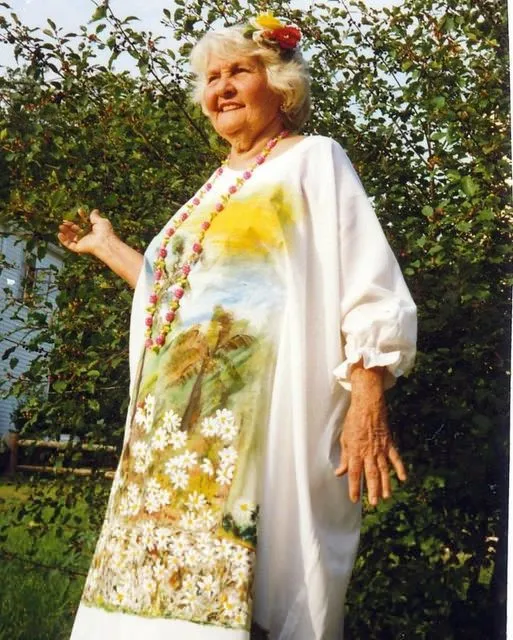 Fuente: Janitze Arratia. @janitzearratia
Fuente: Janitze Arratia. @janitzearratia
language english
Her life and work Margarita Soto the plastic artist and the best midwife.
My grandmother Margarita Soto was born on June 19, 1917. She was known for her vocation of service and for having attended some 5000 births, according to Luis Guillermo Hernández and Jesús Andrade Parra.
She was the founder of the Children's Nursery of Cabimas in 1940. Painter. She was a student of the maestro Vicente Rojas, and acted in theater under his direction, in the plays "Simon Bolívar", which was performed in a temple behind the cathedral and "Doña Rosa", which was in the Cine Varieties.
However, she moved away from the arts for 42 years to devote herself to the work of a midwife. She attended the delivery of the first Conjoined Twins of Cabimas, in the Dr. José Gregorio Hernández clinic. They say that when he had to attend a birth, he moved by donkey, bicycle, truck, whatever it was in order to arrive, at any time, of the day or night.
Many times, she only received the graces of relatives, with scarce economic means. All she demanded was that she be told in advance, that she was going to be the midwife. Later, due to an accident that injured one of his arms, he decided to resume his artistic vocation.
In her paintings he narrated everyday motifs, events of his environment, religious festivals, fairs and historical themes. Particularly his work is characterized by the presence of children, of the childish, which is reflected in almost all his characters. Likewise, in his paintings the use of pure colors predominates, especially blue and yellow, with which he achieved nuances that gave an atmosphere of joy to the scenes described.
In 1984 he made a solo show at the Casa de la Cultura Juan Félix Sánchez, in Mérida. In 1987 he was part of the exhibition Pintores de Cabimas and the I Biennial of Popular Art Bárbaro Rivas, where he won the Second Prize; both events held at the Museum of Popular Art of Petare, in Caracas.
In 1988 he participated in the Salón Nacional Cervecería de Oriente, in Barcelona (Anzoátegui state), and in the Salón Nacional de Artes Plásticas, in the Popular Art section, in the Museo de Arte Popular de Petare, in Caracas.
The following year she participated in the II Bárbaro Rivas Biennial, and in 1992 he obtained the Painting Prize at the III Bárbaro Rivas Biennial; events held at the Museum of Popular Art of Petare, in Caracas. At the end of that year he participated in the exhibition Imágenes del Genio Popular, organized by the National Art Gallery, in Caracas, with the sponsorship of the Bigott Foundation. Her pieces are included in the collections of the GAN, the Museum of Popular Art of Petare and the Polar Foundation. She was immortalized by "Neguito" Borjas, in her bagpipe "Punta Icotea".
She died on October 10, 1994. Four years after her death, the House Museum was inaugurated in his honor.
language spanish
Margarita Soto nació el 19 de junio de 1917. Fue conocida por su vocación de servicio y por haber atendido unos 5000 partos, según Luis Guillermo Hernández y Jesús Andrade Parra.
Fue fundadora de la Casa Maternal Infantil de Cabimas en 1940. Pintora. Fue alumna del maestro Vicente Rojas, y actuó en teatro bajo su dirección, en las obras "Simón Bolívar", que se realizo en un templete detrás de la catedral y "Doña Rosa", que fue en el Cine Variedades. Sin embargo se alejó de las artes por 42 años para dedicarse a la labor de partera.
Atendió el alumbramiento de los primeros siameses de Cabimas, en la clínica Dr. José Gregorio Hernández.
Cuentan que cuando tenia que atender un parto, se movilizaba en burro, bicicleta, camión, lo que fuera con tal de llegar, a cualquier hora, del día o la noche. Muchas veces, solo recibía las gracias de los familiares, con escasos medios económicos. Lo único que exigía era que le avisaran con tiempo, que ella iba a ser la partera.
Posteriormente, debido a un accidente que lesionó uno de sus brazos, decidió retomar su vocación artística. En sus pinturas narró motivos cotidianos, sucesos de su entorno, las fiestas religiosas, las ferias y los temas históricos.
Particularmente su trabajo está caracterizado por la presencia de niños, de lo infantil, lo cual se refleja en casi todos sus personajes. Asimismo, en sus cuadros predomina el uso de los colores puros, especialmente el azul y el amarillo, con los cuales lograba matices que le imprimían una atmósfera de júbilo a las escenas descritas.
En 1984 realizó una muestra individual en la Casa de la Cultura Juan Félix Sánchez, en Mérida. En 1987 formó parte de la exposición Pintores de Cabimas y de la I Bienal de Arte Popular Bárbaro Rivas, donde obtuvo el Segundo Premio; ambos eventos realizados en el Museo de Arte Popular de Petare, en Caracas.
En 1988 participó en el Salón Nacional Cervecería de Oriente, en Barcelona (estado Anzoátegui), y en el Salón Nacional de Artes Plásticas, en la sección Arte Popular, en el Museo de Arte Popular de Petare, en Caracas.
Al año siguiente participa en la II Bienal Bárbaro Rivas, y en 1992 obtiene el Premio de Pintura en la III Bienal Bárbaro Rivas; eventos realizados en el Museo de Arte Popular de Petare, en Caracas. A finales de ese año participa en la muestra Imágenes del Genio Popular, organizado por la Galería de Arte Nacional, en Caracas, con el patrocinio de la Fundación Bigott. Sus piezas están incluidas en las colecciones de la GAN, el Museo de Arte Popular de Petare y la Fundación Polar.
Fue inmortalizada por "Neguito" Borjas, en su gaita "Punta Icotea".
Falleció el 10 de octubre de 1994. Cuatro años después de su muerte fue inaugurada la Casa Museo en su honor.
#teasesoroparaelexito#lavidademiabuela#margaritasoto#esperoladisfruten#tantocomoyo
`|
 column1|column2|column3|
|-|-|-|
|content1|content2|content3|
``
column1|column2|column3|
|-|-|-|
|content1|content2|content3|
``